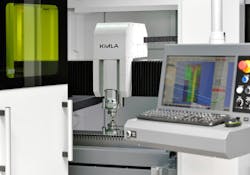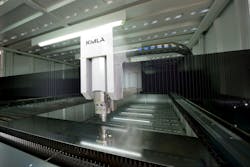It’s obvious that people want to earn money with their laser cutters. Many think that increasing laser power will increase their earnings—sometimes this is true, but sometimes not. If we consider how increasing the power will affect earnings, we should discuss this in detail. When the power range is quite low, any power increase is directly visible in the overall efficiency. As the power increases, the cutting speed increases proportionally, but when the parts are small, the sections over which the laser moves do not allow the cutting speed possible for a given laser power to be used in full.
Increasing the power on small parts is no longer effective, so increasing the power with thin sheets and small details does not make any sense. All these considerations apply to cutting in nitrogen; after a certain thickness, a transition to cutting with oxygen is necessary. However, when cutting with oxygen, the feed rate is much lower and does not increase with increasing power. This means that increasing the power makes sense only for plates of medium thickness. For example, with power of 6 kW, the maximum thickness of cutting in nitrogen is 6 mm—after exceeding this value, cutting in oxygen should begin, which is done at a much lower speed and therefore reduces the overall efficiency. When increasing the power to 8 kW, the maximum thickness of the cut in nitrogen is 8 mm, 10 kW is 10 mm, 12 kW is 12 mm, etc.
High laser powers only make sense for cutting medium thicknesses. For thin sheets, high power cannot be used because the dynamics of the machine is limiting, and for thick sheets, the oxygen cutting technology is limiting. Therefore, if the largest part of a job is a metal sheet that is 8 mm thick, laser with a power of at least 8 kW should be used and if it is, for example, 12 mm, a laser with a power of 12 kW should be used, and so on.
The above dependence shows that further increasing the power to, for example, 15 or 20 kW should almost completely eliminate the need to cut thick sheets in oxygen. Laboratory research confirms this, but is the industry ready for such high power?
The rapid development of fiber laser sources in recent years has resulted in the fact that power capacities of 20 kW or even 30 kW are already available on the market. However, it turns out that their implementation into cutting machines is not so simple. Offering extremely high power looks great in advertising, but can the huge purchase cost really pay off?
The biggest problem is the absorption and loss of energy in the cutting head, which causes overheating of the optical elements. The higher the laser power, the more harmful thermal effects become.
In order for the cutting process to run properly, it is necessary to control many parameters of the process. One of them is the height of the focal point, which must be accurately pre-set for each type and thickness of the cut material.
Due to the optical properties of the glass from which the optical elements are made in the head, the position of the focus point changes with the increase of their temperature, which disturbs the cutting process—this effect is called focus shift. This is difficult to control because the lenses are cold at the beginning of the cut, but they heat up over time and the focal point changes, causing the cut quality to deteriorate or even stop cutting. This effect is proportional to the laser power. With powers up to 6 kW, this effect is negligible, but with higher powers it becomes a problem.
A partial solution is to use special aspherical lenses with low-absorption antireflective coatings, but the absorption and the problem with their overheating increases with time because the optical element quickly degrades when working with high powers, and the higher the power, the faster the degradation. In addition, there is incidental damage to the optics caused by invisible impurities that may get into the head during installation or replacement of the protective glass. The higher the laser power, the greater the risk of serious failures caused by operator error or improper operation.
At low powers, damage to one optical element does not damage neighboring elements. On the other hand, at high powers, the destruction of the optics progresses so quickly that a chain reaction may occur, destroying all parts of the head, including the optical fiber, before the operator even has time to react.
The above-mentioned phenomena means that many companies that have decided to purchase lasers with very high power in the hope of a significant increase in efficiency are not able to take advantage of it.
It turns out that overheating of the optics and its frequent failures generate huge costs and long downtimes. Users of such lasers are often forced to reduce the power to a level at which the laser works stably. Often, it is even half the power they paid for.
It should also be remembered that although the linear cutting speed can be twice as high when doubling the power, it does not translate into doubling the total production efficiency.
In addition to limiting the capacity at high powers due to the thickness of the sheet, as mentioned earlier, increasing the power does not linearly increase the number of parts produced during one shift. After all, increasing the laser power does not shorten the rapid movement between the parts, shorten the time of changing pallets or preparation activities, or shorten the lunch break for the operator.
If choosing 15 kW instead of a 6 kW laser, the price of such a laser can be twice as high. However, the average production efficiency on such a machine, taking into account the entire material thickness range, calculated on the number of elements cut out, will only increase by about 30%.
It turns out, therefore, that allocating the same amount to the purchase of two 6 kW lasers increases production efficiency by 100%. It should also be remembered that with two lasers, in case of downtime, one of the other lasers can continue to cut, ensuring continuity of production.
To sum up, offering very high laser powers indeed causes excitement and the WOW effect. However, it does not translate directly into the expected results, as a 1000 hp car will not cross the city much faster than a 100 hp car.
At Kimla, we have analyzed which factors limit the fiber laser efficiency and it turns out that with thinner sheets, the greatest limitation of efficiency is not the power of the laser source, but the dynamics of machine movements. It also turns out that many laser manufacturers using control systems designed mainly for milling and turning machines that are too slow and waste the potential of modern optical fiber sources due to the need to slow down on complex shapes.
Kimla has developed an error-free position laser control system with Dynamic Vector Analysing that has unique features to allow even very high power to be used on thin sheets. It is a breakthrough solution based on magnetic linear drives, allowing users to achieve extremely high work dynamics, even on complex shapes of small parts (see Fig. 1). Thanks to this solution, one Kimla laser can replace several other laser cutters.The limitations related to high-power laser optics have been solved by using an innovative Lens Care cutting head monitoring system, which constantly controls the temperatures of all optical elements and, based on these measurements, corrects the focus position to solve the problem with focus shift (see Fig. 2). It also allows constant monitoring of the condition of the optics and automatically turns off the laser in the event of an anomaly, preventing serious breakdowns.
Regardless of this, the legitimacy of buying lasers with very high powers should always be individually analyzed, because in many cases it may turn out that high power will significantly increase the cost of purchase and use, and not necessarily increase production efficiency.
ACKNOWLEDGMENT
Dynamic Vector Analysing is a trademark of Kimla.
Przemyslaw Kimla | CEO, Kimla
Przemyslaw Kimla is the CEO of Kimla (Częstochowa, Poland).

